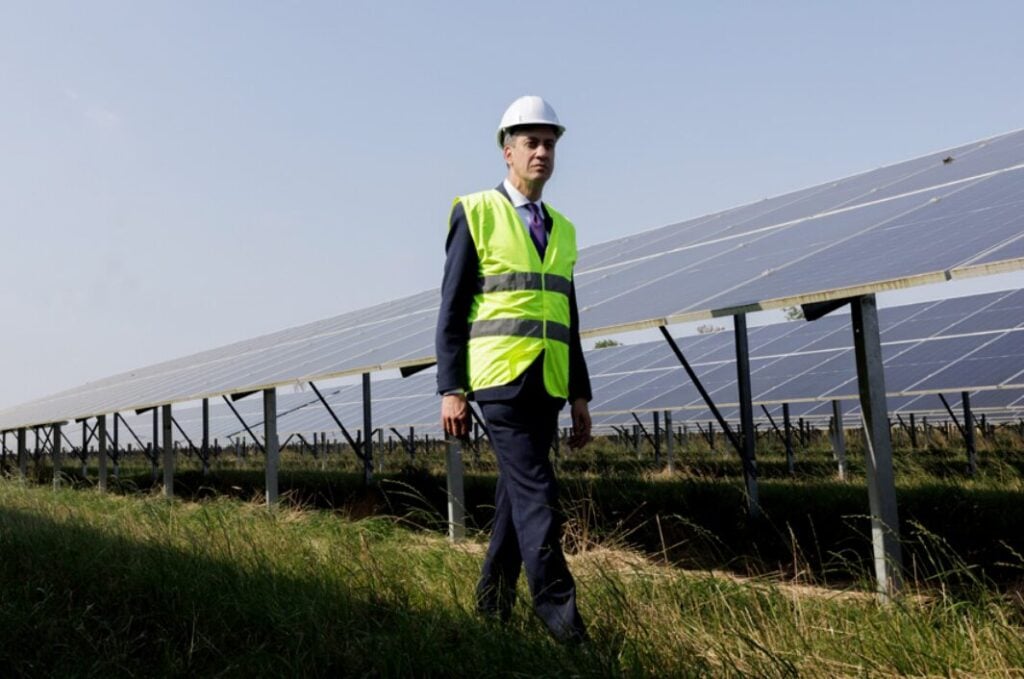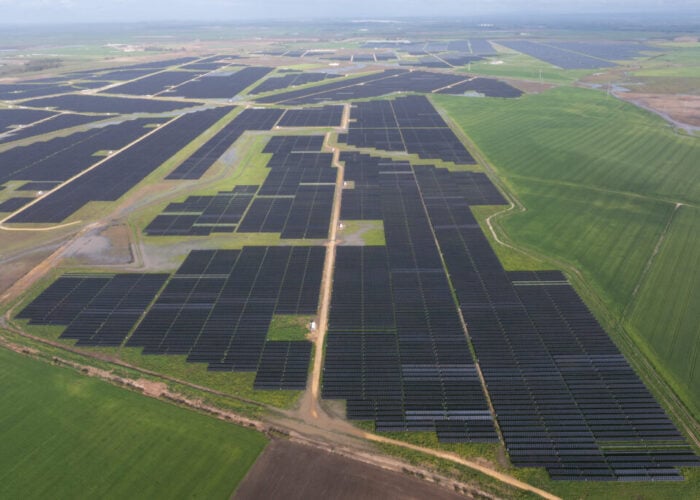
The UK’s new Labour government took power last summer, promising a renewable energy revolution, with solar playing a lead role. A year on from its landslide victory, Molly Green looks at what has been achieved.
Last July, a Labour government was elected to power in the UK, heralding a positive shift for the renewable energy industry.
Try Premium for just $1
- Full premium access for the first month at only $1
- Converts to an annual rate after 30 days unless cancelled
- Cancel anytime during the trial period
Premium Benefits
- Expert industry analysis and interviews
- Digital access to PV Tech Power journal
- Exclusive event discounts
Or get the full Premium subscription right away
Or continue reading this article for free
Voted into government off the back of a manifesto that centred renewables and pledged rapid solar expansion, Labour’s election marked a break from a period during which those in power had, if not actively encouraged, then willingly overseen anti-solar rhetoric that allowed misinformation to circulate.
The new Labour government’s Department for Energy Security and Net Zero (DESNZ) was quick to act. In his first week as energy secretary, Ed Miliband granted development consent orders (DCOs) for three solar plants with a combined capacity of over 1.3GW.
One year on, eight solar nationally significant infrastructure projects (NSIPs) have received a DCO from Miliband, most recently giving the nod to Baywa r.e. for the 140MW Oaklands Farm solar-plus-storage development.
According to Sulaiman Ilyas-Jarrett, former head of policy and strategy, renewable delivery for DESNZ, who now provides private consultancy and hosts the Energy Revolution podcast, “solar has been an unsung success story in the UK over the last year”.
Labour’s manifesto pledged to reach 72GW of installed solar capacity by 2035, after having tripled solar capacity by 2030 to roughly 42GW.
The 2035 target has been slightly lost behind the government’s Clean Power 2030 Action Plan, which details the necessary steps to a majority (98%) renewable energy-powered energy system operating in the UK by 2030. Within this, the government is committed to between 42 and 47GW of solar installed by 2030.
Lead solar analyst for Solar Media Market Research Josh Cornes says that the uptick in solar NSIPs entering the planning system since the election could be the result of improved developer confidence following Miliband’s quick DCO approvals and supportive signals from government, or the CP30 plan pushing them to act sooner than later.
Planning system changes
As promised, the government has changed the UK planning system to make it harder for local authorities to reject solar developments on spurious grounds.
Previously, wording in the National Planning Policy Framework (NPPF) referenced consideration of agricultural land for food production in considerations for renewable energy project applications. The common misconception that solar PV development will lead to food insecurity by taking agricultural land out of commission is one that has been disproven on several counts, including in a statement made by Miliband to the House of Commons in July 2024. Accordingly, in December, the government implemented a reworded NPPF to state that planning authorities should give “significant weight to the benefits associated with renewable and low carbon energy generation and the proposal’s contribution to a net zero future” when determining applications.
The NPPF is aligned with other changes to wording the government made to National Policy Statements (NPSs), which cover NSIPs. Adjustments mean that NPS EN-3 calls NSIPs “critical national priority”, and as such their “national security, economic, commercial and net zero benefits” should outweigh impacts from their development.
These changes were introduced alongside the CP30 Action Plan, but as Chris Hewett, chief executive of the UK solar trade body Solar Energy UK and co-chair of the government’s Solar Taskforce, points out, they will not have a major effect on installed generation capacity until after 2030.
The action plan, Hewett says, creates a welcome urgency to build towards a looming target: “More projects came through from our industry because of that.”
Likewise, Ilyas-Jarrett says it’s “important and useful” to have the 2030 target.
Grid connections: creating winners and losers
When Hewett spoke to PV Tech Power last year in the wake of the election, he was clear that grid connections were the biggest concern for the industry.
Since then, the UK energy regulator Ofgem approved plans put forward by the National Energy System Operator (NESO), the independent body that manages the UK energy system, including gas, for a new way of managing grid connection applications.
In an effort to cut ‘zombie projects’ that apply for a grid connection with little chance of ever being realised from the queue, the new system arranges applications into ‘gates’, prioritising projects that are likely to deliver and are aligned with UK-wide energy policy.
According to Hewett, “it’s fair to say it’s been an uncomfortable process”. The new methodology had to be developed very quickly and has been met with some discontent in the solar industry. Hewett says that because government and NESO moved so fast, it has caused economic ripples in the industry, and throughout the process, which was “pretty opaque”, it was not clear that generators’ views were being properly taken into account.
“There are winners and losers out of it as a whole,” he says.
This is another area in which the situation post-2030 has not been discussed. The flip side of the urgency created by CP30, and the speed at which connection reforms have been implemented, is that there are “probably greater question marks over what’s going to happen between 2030 and 2035”.
The rooftop revolution
The rooftop solar sector in the UK has “done well” out of connection reform, Hewett says.
A long-standing ask of the connections process was that the transmission threshold be raised from 1MW to 5MW in England and Wales. In Scotland, the threshold was raised from 50kW to 200kW in summer 2024.
By raising the capacity at which a rooftop installation needs a transmission impact assessment (TIA), which previously slowed or prevented rollout of larger rooftop PV installations, NESO said it hoped to “release around 400 distributed generation projects from having to demonstrate Gate 2 compliance or alignment with Clean Power 2030 targets”.
At the time, Solar Energy UK issued a “warm welcome” to the news that “a burdensome element of red tape that has added many years to getting projects off the ground”, contributing to the government’s stated ambition to “unleash a rooftop revolution”.
The government had pledged in its manifesto to implement a mandate for all newly built properties in the UK to have rooftop PV systems installed, a policy that had been floated by the previous government.
However, close to a year after its commitment to the rooftop revolution, the policy that had seemed a sure thing from the off was only made official in June 2025, with the Future Homes Standard to be published in Autumn this year and include the mandate.
Speculating on why the government took so long to make good on that pledge, Ilyas-Jarett says: “I’m sure there were inter-ministerial conversations about priorities and how to balance the desire to have increased rooftop solar with the desire amongst the Ministry of Housing and Treasury to build new homes quickly [another of the government’s manifesto promises].”
“That’s front and centre [for DESNZ] but it’s not necessarily there for ministers in the housing industry it’s a more complex policy environment to jump into,” he explains.
Something more in reach for DESNZ was reform to the Contracts for Difference scheme, something Ilyas-Jarett explains effectively uses existing tools.
Last year’s auction round six (AR6) broke records for the highest budget, which Miliband increased to £1.56 billion (US$2 billion), and capacity secured, with 3.3GW solar projects receiving contracts (out of a total of 34.74GW awarded). Shortly after the success of last year’s auction, the government announced its ambition to reform the process for an even bigger capacity in AR7.
To meet CP30 targets, at least 12GW capacity will need to be secured in AR7, AR8 and potentially (depending on speed of deployment) AR9 across all technologies. For its speed to deploy and comparably low cost (in comparison with other technology types included in the auction), solar could meet much of this new capacity.
Changes to the scheme approved on 15 July 2025 include increasing the length of contracts available for wind and solar projects from 15 to 20 years and allowing the energy secretary to view developer bids ahead of setting the final budget.
According to Ilyas-Jarrett, this move gives more forward certainty to industry as to what application rounds will look like for the projects set to be delivered by 2030, something that has been well received.
“CfD privileges medium to large-scale projects in the way that it’s set up,” he points out. “But the area for future growth is smaller scale and domestic solar,” because “from a political standpoint, that kind of domestic rooftop solar will be just as, if not more, important.”
He says this is where the government’s flagship Great British Energy company could play a role: “This small-scale, lower capacity but higher social impact solar [is what] GB Energy could do”.
The state-owned energy company has begun to take shape, after being promised as a flagship entity by the government when it came to power, even if its precise role was initially vague.
Hewett notes that on the launch of GB Energy, the solar industry’s advice was that the investment vehicle-stroke-renewable energy developer use some of the £8.3 billion it is allotted to invest in the public sector—“which is exactly what they’ve done”.
A £200 million investment from the UK government and GB Energy will see the company work with schools and the NHS to install rooftop solar PV on a total of 400 sites, delivering between 70MW and 100MW of solar generation.
In England around £80 million in funding will support around 200 schools, alongside £100 million for nearly 200 NHS sites, with the first solar systems to be installed by the end of summer 2025.
A more recent development in the company’s remit is an amendment to the Great British Energy Bill that sets an obligation to ban the use of solar products with forced labour in their supply chains in its projects. It will also find opportunities to develop “technology sovereignty” by driving the UK’s domestic clean energy supply chain, in line with the UK government’s recently released Industrial Strategy.
Supply chain and the Solar Roadmap
Perhaps the government’s most keenly awaited promise, but arguably the slowest to deliver, has been the Solar Roadmap. Soon after the election, Miliband recalled the Solar Taskforce, co-chairing the group with Hewett as a signifier of the emphasis he placed on its mission.
Hewett says that “you can’t fault the ambition” in the speed at which Miliband moved. The roadmap was first promised for autumn 2024, after a shift to reflect the new government’s increased ambition and one month after its first meeting in September 2024.
Ensuring alignment with the CP30 Action Plan delayed this, and Hewett concedes that Miliband wasn’t able to be “as hands on” with the Taskforce as he would have liked.
However, with the government’s first Spending Review confirming its economic commitment to renewable energy development, the Solar Roadmap has at long last been published—with not an insignificant amount of focus on the supply chain issues.






